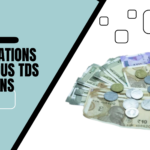Starting from October 1, 2023, a Tax Collected at Source (TCS) rate of 20% will be imposed on all foreign payments, except those related to medical and educational expenses. This TCS will be applicable when the total remittance exceeds Rs 7 lakh in a financial year. It will apply to various foreign remittances, such as the purchase of real estate in a foreign country, investments in foreign stocks, expenses incurred while traveling abroad, and more. It’s important to note that TCS won’t be applicable to expenses paid via credit cards.
If tax has been deducted from your foreign remittances, it is crucial to ensure that this deduction is correctly reflected in your tax documents. It’s essential to understand that TCS is not an additional tax but functions similarly to TDS (Tax Deducted at Source). TCS is applicable to expenses exceeding specified limits, while TDS is applicable to an individual’s earned income.
Any amount collected through TCS can be used by an individual to offset their net tax liability when filing their Income Tax Return (ITR). To verify the TCS amount available against your Permanent Account Number (PAN), you need to refer to four key documents:
1. Form 26AS
2. Annual Information Statement (AIS)
3. Tax Information Statement (TIS)
4. Form 27D (TCS certificate)
Form 26AS serves as a tax credit statement, providing details of all TDS and TCS deductions from various sources throughout the financial year. However, it only displays TDS and TCS deductions and does not cover other tax payments like advance tax or self-assessment tax.
AIS is a comprehensive document that goes beyond Form 26AS. It includes details of TDS, TCS, and other categories such as specified financial transactions (SFT). AIS records income and expenses, regardless of whether tax was applicable to those amounts. For instance, it may include interest earned from savings accounts, even though no TDS applies to such income.
TIS is a summarized compilation of tax-related information categorized for clarity.
AIS, TIS, and Form 26AS can be accessed and downloaded from the income tax e-filing portal.
Form 27D is a TCS certificate issued by the tax deductor to the individual, serving as documentary proof that the entity responsible for TCS collection has deducted and deposited the tax with the government. It’s analogous to Form 16 (TDS certificate) issued by employers.
Rule 37D of the income tax rules mandates the collector to issue a certificate in Form 27D (commonly known as a TCS certificate) for the collection of TCS from the collectee.
The TCS certificate should be issued within the timeline stipulated by tax laws for the respective TCS collector. Individuals should inquire with their TCS collector regarding when they can collect the certificate.
File Your Income Tax Return in Dwarka With Best Chartered Accountant of Dwarka Delhi
Income Tax Return Filing in Dwarka Delhi
What to do if TCS Credit doesn’t match the records
The TCS amount should match in all four documents: Form 26AS, AIS, TIS, and Form 27D. If discrepancies arise where the tax collected amount is not reflected or is lower than the actual deduction, individuals can rectify the differences by requesting the TCS collector to amend the error by filing a TCS correction statement.
In simpler terms, individuals should promptly request the TCS collector to file a corrected TCS return with the accurate amount. All information in these four documents is automatically populated from the TCS return filed by the TCS collecting entity. There is no specific deadline for filing a correction statement (return) for TCS, allowing the TCS collecting entity to file it whenever they notice the error or are informed by the individual. There are no penalties on TCS collecting entities for filing correction statements.
What if a mistake is discovered while filing ITR?
If an individual identifies a discrepancy in the TCS amount during the ITR filing process, they should immediately contact the TCS collecting entity to rectify it.
There are three possible scenarios:
- Correction made before the July 31 deadline: If the TCS data is corrected by the ITR filing deadline, which is July 31, individuals can use the corrected TCS credit amount to file their ITR.
- Correction made after the July 31 deadline but before the December 31 deadline: If the individual requested the TCS collecting entity to make the correction within the original ITR deadline but the correction was completed after July 31, they have until December 31 to file the revised return.
- In cases where there is an expected delay in the TCS collecting entity filing the correction statement of TCS, individuals must file their ITR before the July 31 due date of every assessment year, using the available credit in Form 26AS, AIS, or other sources to avoid late filing fees of up to Rs 5,000. Even if the income tax department processes the ITR before the TCS correction, individuals can file a revised ITR until December 31. Therefore, individuals whose TCS data was corrected after the initial ITR processing can file a revised ITR to claim the correct TCS amount and adjust their net tax liability accordingly.
- Correction made after the December 31 deadline: If the TCS collecting entity corrects the data after the revised ITR deadline of December 31, the individual can use the rectification request option under section 154 to claim the TCS credit. However, this request is subject to certain conditions.
- A rectification request can be filed only if the income tax department has issued a rectification order or upon the individual’s request. It is applicable when there is an apparent mistake in the filed ITR concerning Form 26AS, AIS, and other documents.
After the order is issued, individuals can file a rectification request on the income tax e-filing portal. This request is initiated only if the ITR has been processed with an incorrect TCS amount. In cases where no order has been issued by the income tax department, individuals must submit a rectification request to the department.
Before filing the rectification request, individuals should ensure that the TCS amount mentioned in AIS, Form 26, or other documents has been corrected and does not match the intimation order under section 143(1).
The rectification request must be filed within four years from the end of the financial year in which the intimation order under section 143(1) or section 154 order regarding the original ITR was issued. For individuals seeking to file a rectification request, they have until March 31, 2028, for FY 2022-23 (AY 2023-24) if the intimation/order was issued for FY 2023-24. Similarly, for FY 2019-20 (AY 2020-21), the deadline for filing a rectification request is March 31, 2024, if the intimation/order was issued for FY 2019-20.


